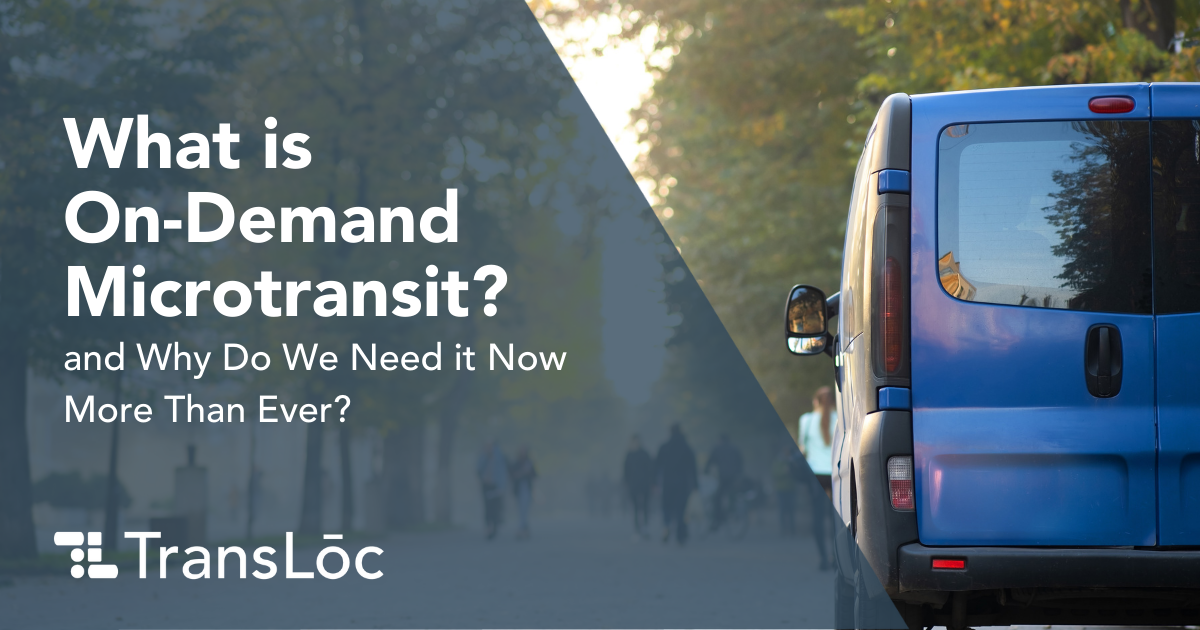
Your Google search ends here.
On-demand microtransit is a flexible and dynamic demand-response mode of passenger transportation. Riders request a vehicle (typically a small van or shuttle) through a mobile app (or by calling a dispatcher) to pick them up and drop them off at a location.
Sound familiar to your favorite ride-hailing service? The tech may be similar, but as we’ve discussed before, transit agency-owned on-demand microtransit allows for seamless integration into the agency’s service portfolio in a way that transportation network companies cannot.
Why do riders and transit agencies need on-demand microtransit now more than ever?
1. Accessibility: The Freedom of Movement for All
On-demand microtransit addresses the first mile/last mile (FM/LM) conundrum; or how riders begin and end their journey on public transportation.
Since traditional fixed-route services travel along a preset route and require riders to wait at a designated stop to board a transit vehicle, they thrive in densely-populated cities where riders can walk or bike a reasonable distance to a designated stop. On average, riders in major metropolitan areas are willing to walk 5-10 minutes, or a quarter-to-half a mile, to a transit stop.
But not every American lives in major urban centers. You’ve heard the term suburban sprawl before. Well, suburban sprawl — the migration of a city’s population to suburban and rural communities — is a vulnerability for fixed-route services. Sprawl has created many areas without access to convenient transit services (a.k.a., transit deserts; more on this in a moment). Unfortunately, creating new fixed-route lines that extend miles and miles from a transit hub is a costly risk for transit agencies. Running an empty bus around the outskirts of town helps no one.
On-demand microtransit, coupled with analysis of agency-owned transit data, allows transit planners to “geo-fence” under-served regions or zones, thus creating a unique on-demand ride-hailing service for those communities. Riders who live more than a mile away from a fixed-route stop could rely on an on-demand microtransit service to pick them up and take them to the nearest stop. By acting as a feeder to fixed-route services, transit agencies will access a larger percentage of the population. That means more riders, fewer empty buses, and greater community engagement.
How effective is on-demand microtransit in strengthening the connection between urban centers and suburbia? Ask Plymouth Metrolink, the innovative transit leaders in Minneapolis-Saint Paul’s third-largest suburb.
By deploying a new fleet of on-demand shuttle buses, suburban residents could request a group pickup at neighborhood landmarks and be transported to Plymouth’s busiest locales without dealing with congested roadways. This was especially a boon for the city’s aging population, who had been traditionally underserved by current public transit services. Suburban residents of all ages can now enjoy community amenities and popular businesses that were originally out of reach.
2. Flexibility: Adapting to Community Needs
The truth is that operating a public transportation service is expensive, and its success is sometimes influenced by factors beyond a transit agency’s control (see: a once-in-a-century global pandemic).
Transit agencies often face tough decisions when reducing services in order to stay afloat. Routes with low ridership are usually the first casualty. But remember: low does not mean zero. For riders who depend on transit, shutting down a poor-performing route means they potentially lose their only form of transportation. This creates a transit desert — an area that lacks adequate public transportation for those who are transit-dependent.
On-demand microtransit brings life to transit deserts by enabling transit agencies to operate with the mindset of flexibility instead of elimination. By supplementing low-performing fixed routes with more flexible and dynamic on-demand services, transit agencies can deliver a responsive mode of transportation that meets riders where they are, and takes them to where they want to go. Plus, the smaller vans and shuttles used for on-demand microtransit require less fuel and maintenance compared to a standard fixed-route bus — yes, that’s the sound of money dropping back into the piggy bank.
This fixed-to-flex approach benefited the Napa Valley Transportation Authority (NVTA) and its riders. By providing flexible on-demand transit options based on data analysis of rider habits throughout the COVID-19 pandemic, NVTA was able to increase its ridership each month, offer shorter direct trips, and implement social distancing measures that were compliant with the Centers for Disease Control guidance.
3. COVID-19: An Issue of Community Health
When we polled 1,200 U.S. working adults in July 2021, 71% of them expressed concerns about vehicle sanitation and virus exposure when riding public transit.
Transit agencies are working diligently to alleviate public health concerns catalyzed by the COVID-19 pandemic. Mask mandates, vehicle air filtration systems, and new cleaning procedures are being used to build back rider trust. The biggest challenge though is capacity management, especially during peak travel times on fixed-route services.
For riders who are not ready to board a bus full of passengers, on-demand microtransit is a preferable alternative. Riders can pre-book a seat when requesting a ride while transit agencies can control the number of seats available for a particular trip to space out riders and drivers to meet agency or government policies.
How do you implement an on-demand microtransit service?
You need a partner; one with planning and technological expertise who speaks transit data, listens to the needs of your community, and collaborates with you on a unique on-demand solution.
At TransLoc, our Planning and Design Services and OnDemand platform are the perfect pair for transit agencies to launch a customized on-demand microtransit solution. Chat with us today, and let’s investigate how on-demand microtransit can empower your community to move with confidence.